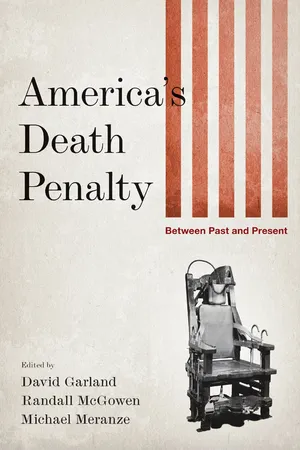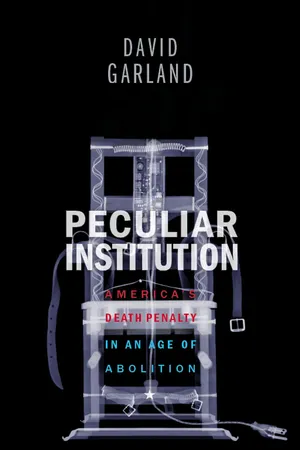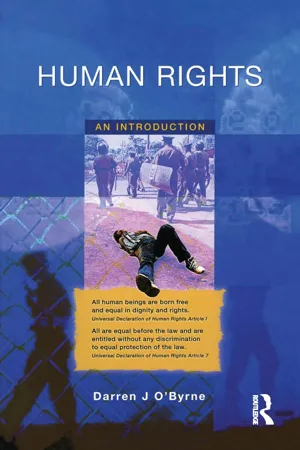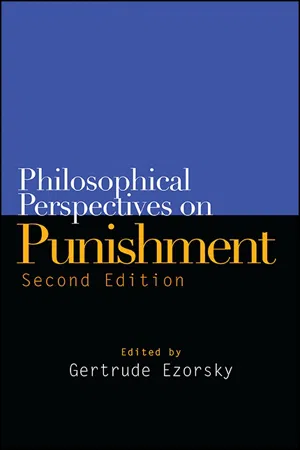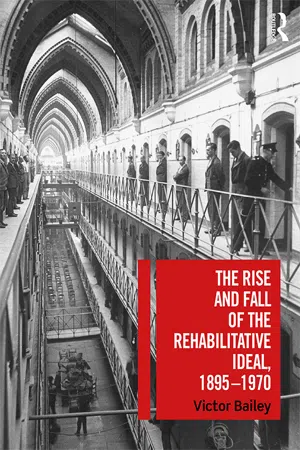History
Capital Punishment in UK
Capital punishment in the UK has a long history, with various methods such as hanging, beheading, and later, the use of the guillotine. The death penalty was abolished for murder in 1965 and completely abolished in 1998. The UK's approach to capital punishment has evolved over time, reflecting changing societal attitudes and a growing emphasis on human rights.
Written by Perlego with AI-assistance
Related key terms
5 Key excerpts on "Capital Punishment in UK"
- eBook - ePub
America's Death Penalty
Between Past and Present
- David Garland, Randall McGowen, Michael Meranze(Authors)
- 2011(Publication Date)
- NYU Press(Publisher)
The Death Penalty in Historical Perspective DAVID GARLANDCapital punishment has been practiced in most known societies over the course of human history. In modern liberal democracies, however, the legitimacy and effectiveness of the institution have increasingly come into question. In these nations, with their commitment to limiting state violence, promoting social welfare, and respecting human dignity, the death penalty exists, if it does, in tension with important political institutions and cultural commitments. Where not altogether abolished—as it is throughout Europe and most of the western world—such societies now use the death penalty much less often and in forms that are increasingly restrained and refined.This transformation is remarkable. The death penalty once formed an elementary particle of governmental power in every nation state. Today the practice is widely regarded as shameful and is prohibited throughout most of the Western world. What happened?The death penalty can be defined as a practice whereby a properly constituted public authority puts to death a convicted offender as punishment for a crime. It is distinct from unauthorized forms of killing, such as revenge killing, murder, or lynching, and from non-penal forms of state killing, whether legal (human sacrifice, killing in war) or illegal (political killings, summary executions). Stripped to its essence, it involves nothing more elaborate than putting lawbreakers to death—an undertaking that has obvious utility for group authorities and is readily available without the need of elaborate technology, know-how, or social arrangements. These characteristics, together with its capacity to terrorize anyone who fears death, explain why the death penalty was close to a cultural universal for millennia prior to the nineteenth century.1 - eBook - ePub
Peculiar Institution
America's Death Penalty in an Age of Abolition
- David Garland(Author)
- 2012(Publication Date)
- Harvard University Press(Publisher)
26 But in other Western societies, national governments have ensured that these lethal, vengeful forces have been disarmed and disempowered. Whenever they threaten to emerge they are represented by officials as regrettably primitive, subjected to normative prohibition, and denied access to law-making processes. In these other societies, the issue of capital punishment has been settled, once and for all, at the national center of government, not decided on a discretionary, case-by-case basis by local actors at the periphery.In a series of fateful decisions, the Supreme Court has repeatedly returned the power of life and death to the environment most prone to demand the execution of offenders. In doing so, the Court has chosen to align itself with the populist, localistic, democratic ethos of the American polity rather than take a stand against it.27 The overall result—especially in states with high levels of violence and low levels of group solidarity—has been the sustained use of the death penalty, a racialized distribution of death penalty sentences, and the development of capital punishment practices designed to benefit the political and professional actors involved.28Since the emergence of modern liberalism in the eighteenth century, every Western society has rendered the use of capital punishment politically problematic and culturally transgressive. The United States is no exception. American society exhibits strong political and cultural norms upholding the sanctity of human life, limiting state violence, and imposing civilized, humane restraints on the ill treatment of individuals. Every Western society also experiences public demands for harsh punishment and the expression, from time to time, of pro–death penalty sentiments. But the intensity of these sentiments differs from place to place, as does the probability of their expression in law and policy. America’s political institutions have shaped that balance of forces and the means of their expression, making it more likely in America than in other Western nations that the death penalty will be retained.29 - eBook - ePub
Human Rights
An Introduction
- Darren O'Byrne(Author)
- 2014(Publication Date)
- Routledge(Publisher)
They manifest themselves in methods as well as processes of execution. While the most notable example is the racist and arbitrary application of the system in the USA, in truth the severity of a punishment has always reflected issues of status and class. Historically, even methods of execution have differed between those in diffferent class groups. In ancient Greece, freemen were treated to a quick death by poison, while slaves were beaten or stoned. In ancient Rome, citizens were either stoned or thrown off the Tarpeian Rock, while slaves and non-citizens suffered crucifixion. In medieval England, the gentry were beheaded, while others were hanged. By understanding the death penalty in practice, and its arbitrary use therein, we are better able to understand its hidden agenda, and its use as a political (rather than a solely ethical-legal) instrument. In this respect, we may wish to return to the earlier chapters on censorship and political imprisonment. In these chapters, we discussed the theories of Louis Althusser. 70 While we have focused in this chapter primarily on the death penalty as a violation of human rights which is exercised within the legal sphere, it is clearly open to manipulation by the political sphere, and as such can be understood as a repressive state apparatus. Also, it is often argued that the harshness of a punishment reflects not the crime itself but the extent to which the crime has captured the imagination of the public. Punishment thus becomes nothing more than a means of securing political support by responding to the public mood. It can also be used arbitrarily to reflect wider cultural divisions within societies. The experience of Death Row As we have seen, Ernest van den Haag, a supporter of the death penalty, nevertheless criticises aspects of its practice in the United States - Gertrude Ezorsky, Gertrude Ezorsky(Authors)
- 2015(Publication Date)
- SUNY Press(Publisher)
English Constitution, thus expressed himself as being favourable to the abolition of capital punishment—For my own part, I do not doubt for a moment either the right of a community to inflict the punishment of death, or the expediency of exercising that right in certain states of society. But when I turn from that abstract right and that abstract expediency to our own state of society—when I consider how difficult it is for any Judge to separate the case which requires inflexible justice from that which admits the force of mitigating circumstances—how invidious the task of the Secretary of State in dispensing the mercy of the Crown—how critical the comments made by the public—how soon the object of general horror becomes the theme of sympathy and pity—how narrow and how limited the examples given by this condign and awful punishment—how brutal the scene of execution—I come to the conclusion that nothing would be lost to justice, nothing lost in the preservation of innocent life, if the punishment of death were altogether abolished. In that case a sentence of a long term of separate confinement, followed by another term of hard labour and hard fare, would cease to be considered as an extension of mercy. If the sentence of the Judge were to that effect, there would scarcely ever be a petition for remission of punishment, in cases of murder, sent to the Home Office. The guilty, unpitied, would have time and opportunity to turn repentant to the Throne of Mercy.Now, the first objection which he (Mr. Gilpin) had to the punishment of death was its essential injustice. They gave the same punishment to the crime of a Rush or a Manning as they did to that of a Samuel Wright, and other less guilty persons. They had, under the present law, constant occurrences in which the feeling, intellect, judgment, and Christianity of the public were against carrying out the extreme penalty, even in cases where the law was clear and unmistakable as to the matter and there was every reason to believe that it had been justly administered by the Judge who had condemned the criminal. Take, for instance, the case of the woman Charlotte Harris. She was sentenced to death, being enceinte- Victor Bailey(Author)
- 2019(Publication Date)
- Routledge(Publisher)
126 These statements have the ring of special pleading. They were excessive praise for a report that was renowned more for what it did not recommend—the abolition of the death penalty—than for what it did, and for proposals that ranged from the technical to the recondite, the bulk of which were destined to have only a marginal impact on the administration of the death penalty. A more sober response, but none the worse for that, came from H. L. A. Hart, professor of jurisprudence at Oxford:What then is the upshot of the mass of information assembled in this Report? It seems to me to be this. The Report shows that the death penalty is a clumsy instrument; and that we use it very largely in the dark. It is clumsy because its use by the law courts is only made tolerable by an anomaly, the intervention in nearly half the cases by the executive. And we use it in the dark because there is no evidence that it has the desired effect on our social life.127Moreover, the royal commission effectively silenced the national debate on capital punishment for close to five years, during which time 84 people were hanged in England and Wales, all the time giving the stage to witnesses who reaffirmed the denunciatory and deterrent necessity of capital punishment, who attacked the use of executive clemency and the frequency of reprieves, and who claimed, as The Times opined, “we have little to reproach ourselves with about the way in which the community uses [the gallows].”128 What we now know to be the last gasps of judicial resistance to abolition were on full display. The Lord Chief Justice was against raising the age of execution of youths from 18 to 21; saw no reason not to hang women; and was in favour of retaining the black cap: “I think you want to make it a very solemn occasion, and I think those things which emphasise the solemnity of the occasion are all to the good.” For the Archbishop of Canterbury, the death penalty served a quasi-religious function of denouncing wrongdoing. There is merit in the view that the commission at least passed the buck back to Parliament with the rider that the present law was incapable of amendment except through abolition. But this was to lead to Churchill’s Conservative government delaying even discussing the content of the report, let alone acting upon the commission’s recommendations, so frightened was it of allowing the genie of abolition out of the parliamentary bottle. The government’s refusal to act on the report led Cabinet Secretary, Norman Brook, to say to Prime Minister Churchill, “The work of this Royal Commission occupied 4½ years and cost £23,000 . . . [and] seems to have been a lamentable waste of public time and money.”129 Christoph was surely right to conclude: “ . . . the activities of the Royal Commission on Capital Punishment would not have been sufficient to excite public or Parliamentary attention in such a way as to bring about changes in basic attitudes.”130
Learn about this page
Index pages curate the most relevant extracts from our library of academic textbooks. They’ve been created using an in-house natural language model (NLM), each adding context and meaning to key research topics.
